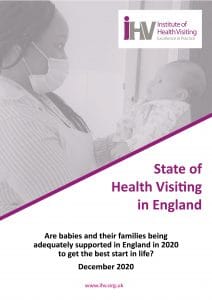21st December 2020
The Institute of Health Visiting today publishes the findings from its annual survey of health visitors in England. The findings lay bare the damage that the pandemic has had on families, with the youngest and most vulnerable in our society suffering the most.
Health visitors are concerned that the needs of vulnerable babies and young children are invisible as they are only able to focus on what feels like the “tip of a very large iceberg” of unmet need, with almost two-thirds of health visitors reporting an increase in cases of child neglect.
Four out of five health visitors report soaring increases in domestic violence and abuse, perinatal mental illness, and the negative impact of poverty on families.
Alison Morton, Deputy Executive Director at the Institute of Health Visiting, said:
“Babies and young children were largely invisible in the first wave of the Government’s emergency plans. With a growing body of evidence, we now know that many children are being harmed by the secondary impact of the pandemic and we cannot knowingly overlook their needs again, as we live with the virus for the foreseeable future.”
Despite the indisputable evidence that the first 1001 days are the most crucial period of human development, babies and young children have largely been forgotten by policy makers, as the Government focused on the more conspicuous need to treat infected patients, mostly adults.
Babies and young children in disadvantaged families have been disproportionately impacted by COVID-19 due to compounding factors like overcrowded housing with lack of outdoor space, the impact of poverty, and parental stress and anxiety, with more families tipped into vulnerability.
Following years of cuts to the public health budget, health visiting entered the pandemic in an already depleted state, with a 31% reduction in health visitors since 2015. Cuts have consequences and these were compounded by the decision to redeploy more than 50% of health visitors in some areas, the national scaling back of the service, and the loss of many face-to-face home visits. As a result, many health visiting services were ill-prepared to meet the rapidly rising levels of need since the earliest weeks of the lockdown, leaving many vulnerable babies and young children without the support that they need.
Sally Hogg, Head of Policy and Campaigning at the Parent-Infant Foundation and Coordinator of the First 1001 Days Movement, commented:
“This report adds more powerful evidence to the growing body of research showing the impact of the pandemic on babies, their families and the services that support them. It paints a worrying picture of increased risks to babies and widening inequalities. Despite the hard work of many passionate and skilled professionals, depleted services across the country are not resourced to provide the support that many families so desperately need. Our babies are our future, and their needs must be taken seriously. Government cannot ignore this issue any longer, investment is urgently needed, and action is long overdue. Babies can’t wait.”
The findings also expose significant flaws in the way the nationally funded health visiting service is prioritised and delivered, with a postcode lottery of support which requires urgent attention to ensure all children achieve the best start in life.
It is imperative that a long-term plan is put in place to protect the health visiting workforce, which provides a vital “safety-net” for our most vulnerable members of society and ensures that the crucial services they provide are no-longer at risk from policy changes by subsequent governments. The Rt Hon Andrea Leadsom MP’s review into improving health outcomes in babies and young children is an opportunity to think differently about services for families and how they are resourced.
Alison Morton concluded:
“Whilst the vaccine brings the glimmer of a “light at the end of the tunnel”, babies and young children cannot wait – they need help now. Failing to effectively address their needs will only store up significant problems for the future.”
iHV State of Health Visiting Survey 2020
Our 7th annual survey was completed by 1012 health visitors from across the UK during October and November 2020. This report presents the findings from 862 health visitors in practice in England and highlights the range of issues facing the profession, with significant unwarranted variation in the quality of services available to parents depending on where they live.
Headline findings:
Widening inequalities with increased safeguarding risks and need:
82% of health visitors reported an increase in domestic violence and abuse
81% an increase in perinatal mental illness and poverty
76% an increase in the use of food banks and speech/communication delay
61% reporting an increase in neglect
45% an increase in substance abuse.
All of which represent key Government priorities to reduce inequality and the cumulative burden of late intervention across government departments.
A reduction in the capacity of the service to support families. Health visiting entered the pandemic in an already depleted state, with its capacity to support families further reduced due to the redeployment of over 50% of health visitors in some areas, the NHS categorisation of the health visiting service as a “partial-stop” service in the Community Prioritisation Plan and the shift to “virtual contacts” in a service that was not designed to be delivered in this way.
Whilst technology has provided a useful alternative to face-to-face contacts for some parents, 89% of health visitors felt that video contacts were not as effective as face-to-face contacts for identifying needs/ enabling disclosure of risk factors in their work with vulnerable families. This will leave many vulnerable babies and young children invisible to services and without the support that they need.
Unmanageable caseloads: Health visitors’ capacity to support families and identify vulnerability is dependent on their ability to work with families and build trusting relationships to elicit need and broker engagement in early intervention: 65% of health visitors had caseloads with over 300 children under 5 years. 29% of health visitors report caseloads of 500+ children. Worryingly, 12% of health visitors report caseloads of over 700 children (one health visitor reported a caseload of 3000 children). N.B. the optimum maximum caseload for effective practice is 250 children, and less in areas of high vulnerability.
A third of health visitors surveyed feel they are ‘stretched and there may be a tragedy in our area at some point’.
A lack of consistency in support offered to families, dependent on where they live. 65% of health visitors said that, “Focusing solely on those most at risk (safeguarding) leaves limited capacity to deliver prevention/ early intervention”
56% were concerned that they were only reaching the “tip of the iceberg”, raising concerns about families who are “seldom reached” by support services.
The impact of the current state of health visiting on workforce wellbeing: 75% of health visitors report increased levels of work-related stress.








